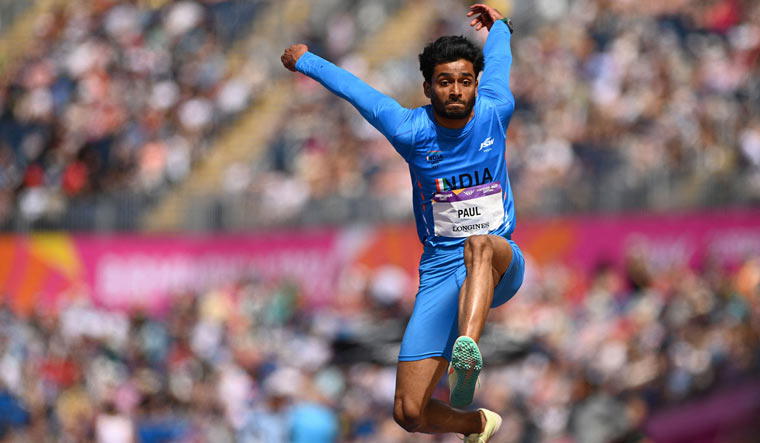World Championships helped me realise
by Yoogasreekumar| 12, Aug,2022
Eldhose Paul
Eldhose Paul born 7 November 1996 is an Indian athlete who competes in the triple jump. In 2022, he became the first Indian to qualify for the final of the triple jump at the World Athletics Championships. At the 2022 Commonwealth Games, he became the first Indian to win a gold medal in the men’s triple jump.
June 2022 was a new beginning for young triple jumper Eldhose Paul, who was competing in a foreign event for the first time in Kazakhstan’s capital Almaty. While the quality of competition was not something to look forward to with no major international names in the field, it was the cold air that was blowing through his nostrils and the unfamiliar central Asian conditions that were the challenge of the day.
“It was more of a suffering than competing,” the Commonwealth Games gold medallist tells Firstpost from Bengaluru. “I never witnessed such harsh weather before. It gets cold in India as well in winters but nothing prepared me for Almaty.” The stakes were only getting high for the young man in a month’s time as he had to compete against the best names at the World Athletics Championships followed by the Birmingham Commonwealth Games.
The Worlds were a further eye-opener as Eldhose Paul just couldn’t get those big jumps in the chilly, windy Oregon weather. His 16.79m effort in the triple jump final was still a welcome sight as he finished ninth in the 12-man showdown.
However, the triple jumper knew the results were a mere footnote in a tournament dominated by javelin thrower Neeraj Chopra’s silver medal and could very well be the case in Birmingham as well if he didn’t step things up soon.
What made Eldhose paul believe he could still pull it off was the fact that he is capable of the big jumps, something he proved time and again at the domestic competitions with top spot at the National Open and at the Federation Cup.
“It was confusing at the beginning, to be honest. Competing with names whom you only saw on YouTube before. Took a while for me to understand this is where I belong. By the end of the World Championship, I knew I needed my body to get used to the conditions as soon as possible,” said Eldhose.

Triple Jump
The triple jump, sometimes referred to as the hop, step and jump or the hop, skip and jump, is a track and field event, similar to the long jump. As a group, the two events are referred to as the “horizontal jumps”. The competitor runs down the track and performs a hop, a bound and then a jump into the sand pit. The triple jump was inspired by the ancient Olympic Games and has been a modern Olympics event since the Games’ inception in 1896.
According to World Athletics rules, “the hop shall be made so that an athlete lands first on the same foot as that from which he has taken off; in the step, he shall land on the other foot, from which, subsequently, the jump is performed.”
The current male world record holder is Jonathan Edwards of the United Kingdom, with a jump of 18.29 m (60 ft 0 in). The current female world record holder is Yulimsar Rojas of Venezuela, with a jump of 15.74 m (51 ft 7+1⁄2 in).
Historical sources on the ancient Olympic Games occasionally mention jumps of 15 meters or more. This led sports historians to conclude that these must have been a series of jumps, thus providing the basis for the triple jump. However, there is no evidence for the triple jump being included in the ancient Olympic Games, and it is possible that the recorded extraordinary distances are due to the artistic license of the authors of victory poems, rather than attempts to report accurate results.
The triple jump was a part of the inaugural modern Olympics in 1896 in Athens, although at the time it consisted of two hops on the same foot and then a jump. In fact, the first modern Olympic champion, James Connolly, was a triple jumper. Early Olympics also included the standing triple jump, although this has since been removed from the Olympic program and is rarely performed in competition today. The women’s triple jump was introduced to the Atlanta Olympics in 1996. In Irish mythology, the geal-ruith (triple jump), was an event contested in the ancient Irish Tailteann Games as early as 1829 BC.

Approach
The approach is one of the most important parts of an athlete’s jump. The athlete sprints down a runway to a takeoff mark, from which the triple jump is measured. The takeoff mark is commonly either a piece of wood or similar material embedded in the runway, or a rectangle painted on the runway surface. In modern championships, a strip of plasticine, tape, or modelling clay is attached to the far edge of the board to record athletes overstepping or “scratching” the mark, defined by the trailing edge of the board. These boards are placed at different places on the runway depending on how far the athlete can jump. Typically the boards are set 40 ft, 32 ft, and 24 ft from the pit. These are the most common boards seen at the high school and collegiate levels, but boards can be placed anywhere on the runway. There are three phases of the triple jump: the “hop” phase, the “bound” or “step” phase, and the “jump” phase. They all play an important role in the jump itself. These three phases are executed in one continuous sequence. The athlete has to maintain a good speed through each phase. They should also try to stay consistent to avoid fouls.
Hop
The hop begins with the athlete jumping from the take-off board on one leg, which for descriptive purposes, will be the right leg. Precise placement of the foot on the take-off is important in order for the athlete to avoid a foul. The objective of the first phase is to hop out, with athletes focusing all momentum forward. The hop landing phase is very active, involving a powerful backward “pawing” action of the right leg, with the right take-off foot landing heel first on the runway.
Step
The hop landing also marks the beginning of the step phase, where the athlete utilizes the backward momentum of the right leg to immediately execute a powerful jump forwards and upwards, the left leg assisting the take-off with a hip flexion thrust similar to a bounding motion. This leads to the step-phase mid-air position, with the right take-off leg trailing flexed at the knee, and the left leg now leading flexed at the hip and knee. The jumper then holds this position for as long as possible, before extending the knee of the leading left leg and then immediately beginning a powerful backward motion of the whole left leg, again landing on the runway with a powerful backward pawing action.
Jump
The step landing forms the take-off of the final phase (the jump), where the athlete utilizes the backward force from the left leg to take off again. The jump phase is very similar to the long jump although most athletes have lost too much speed by this time to manage a full hitch kick, and mostly used is a hang or sail technique.
Foul
A “foul”, also known as a “scratch,” or missed jump, occurs when a jumper oversteps the takeoff mark, misses the pit entirely, does not use the correct foot sequence throughout the phases, or does not perform the attempt in the allotted amount of time (usually about 90 seconds). When a jumper “scratches,” the seated official will raise a red flag, and the jumper who was “on deck,” or up next, prepares to jump.













